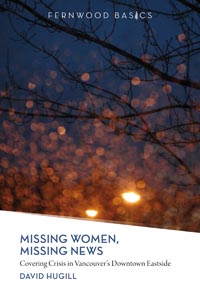Missing Women, Missing News: Covering Crisis in Vancouver’s Downtown Eastside
Review By Tyler McCreary
November 4, 2013
BC Studies no. 170 Summer 2011 | p. 181-183
In a publication coincident with the launch of the inquiry into the police investigation of convicted serial killer Robert Pickton, David Hugill’s Missing Women, Missing News poses a vital and timely challenge to common-sense frames for understanding the crisis of missing women in Vancouver’s Downtown Eastside. Exploring national newspaper coverage of the arrest and trial of Pickton, originally charged with murdering twenty-six street-level sex workers, Hugill argues that the media failed to present the public with a framework within which to critically understand what made this crisis possible. Media discourse continued to circulate images of street-level sex workers and the space of the Downtown Eastside as morally corrupt and degenerate. While journalists focused on bringing attention to the fringes, their “analysis fail[ed] to interrogate the existence of the fringe itself” (29). While the news coverage offered a series of coherent explanations to hold police accountable for their malfeasance, Hugill exposes the media’s omission of the broader social and political context that rendered violence against marginalized women possible. Thus, an overly simplified media narrative failed to contextualize sex workers’ marginality within the raced and gendered context of state abandonment of social services, colonialism, and the criminalization of sex work.
Working within a Marxist framework, Hugill provides a cogent argument that registers both the centrality of material factors in shaping the experience of marginalization and the importance of organizing marginalized communities to engage in the struggle to reconstruct social solidarity. The readability of Hugill’s text demonstrates that one does not need to adopt obtuse or indecipherable language to disrupt reigning common-sense frameworks. With a broadened historical awareness and spatial sensitivity, Hugill maps the series of dispossessions and disavowals that rendered particular women vulnerable in a place of marginality. He ably reconstructs the silences in the prevailing media narrative, which placed gendered vulnerability in the context of state policies that stripped women of social supports, particularly Aboriginal women, while criminalizing sex work. In the most compelling section of the work, Hugill contends with the media’s geographic accounts of the crisis. While the media located the violence of these street-level sex workers’ lives and deaths in the dynamics of their neighbourhood, Hugill situates it within a longer history. Disrupting a naturalized portrayal of Vancouver’s Downtown Eastside as a space of depravity, he positions that place within the historical process of the production of urban space. Historicizing the fragmentation of urban space through a series of gentrification projects and stroll evictions that worked to co-locate deprivation and street-level sex work in the Downtown Eastside, Hugill provides a powerful antidote to common-sense accounts of skid row as autogenetically produced.
However, while the account of urban dispossession is the strongest section of Missing Women, Missing News, the account of colonial dispossession is the weakest. Hugill adroitly recounts the gendered exclusions of federal Indian policy and notes the impact of residential schools. However, he fails to relate either of these policies to the broader strokes of the well-documented history of deterritorializing Aboriginal space through colonial land policies, as does Cole Harris in Making Native Space (UBC Press, 2002). This is a crucial lapse as the foundations of Vancouver rest with the historical reterritorialization of Aboriginal into colonial space and the concomitant disruption of the traditional kinship-based networks of social solidarity within Aboriginal communities. However, Hugill develops his arguments through inverted chronologies. Centering the withdrawal of the state through the last two decades within his critique, Hugill’s book can be read as a lament for the welfare state that fails to convey the extent to which that state was grounded in the historic dispossession of Aboriginal peoples and the disruption of their pre-existing networks of social solidarity.
Hugill registers the contested and contestable terrain of the political sphere. However, in failing to take a longue durée approach to colonialism, he misses the dynamic of colonial dispossession and Aboriginal resistance. Addressing this gap would fundamentally reorganize his argument, but it would also render it far more internally consistent as, for Hugill, a critique of silencing does not preclude the possibility of engaging subjugated knowledges. Indeed, his critique appears in part to be motivated by the way the media controlled the moment of crisis that the Pickton trial represented. The case of the missing and murdered women presented the opportunity to expose the workings of race, class, and gender in the neoliberal colonial state. Hugill effectively bares the ideological bias of the national newspaper coverage, but in penning a threnody to the welfare state, he inadvertently fails to account for his own ideological investment in colonial frameworks. In his conclusion, Hugill argues that it remains necessary to recognize the leadership of oppressed communities in struggles to reconstruct networks of social solidarity and to build a more fundamentally just world. This is a potent call to responsibility; following this call, however, entails extending the terms of Hugill’s analysis to position gendered violence and the criminalization of the Canadian margins within a critical history of the settler state.
Missing Women, Missing News: Covering Crisis in Vancouver’s Downtown Eastside
By David Hugill
Halifax, Fernwood Publishing, 2010, $17.95 paper

